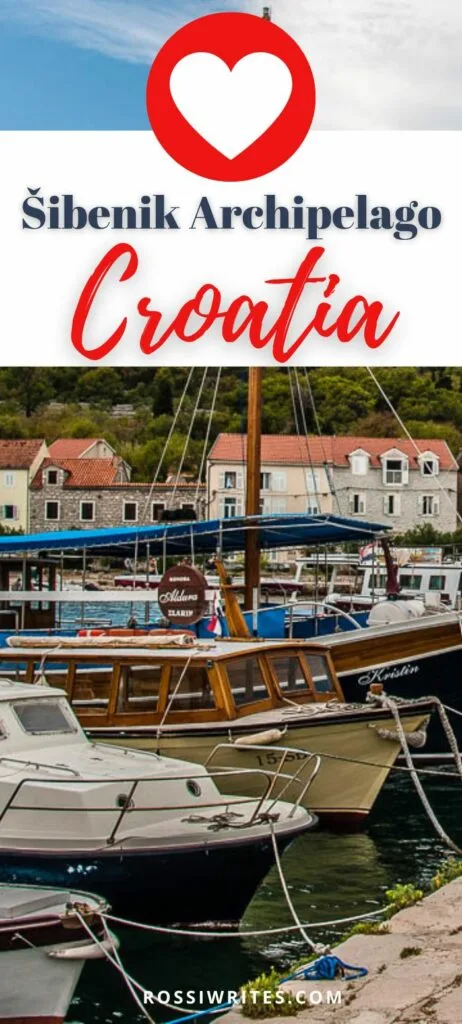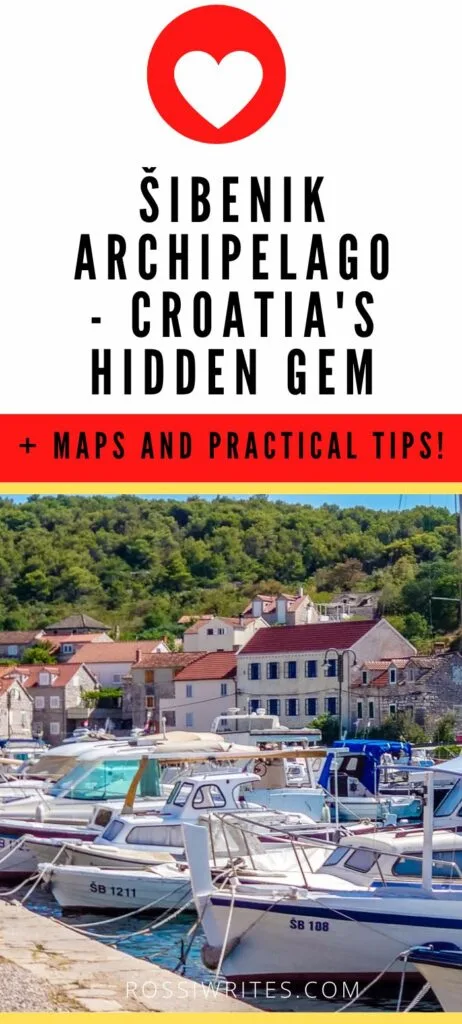The Šibenik Archipelago is a magical place in the Adriatic Sea in Croatia.
Made of 249 islands with only six of them permanently inhabited, here is how to visit and the best things to do in this little-known, laid-back destination in the heart of the Dalmatian coast.
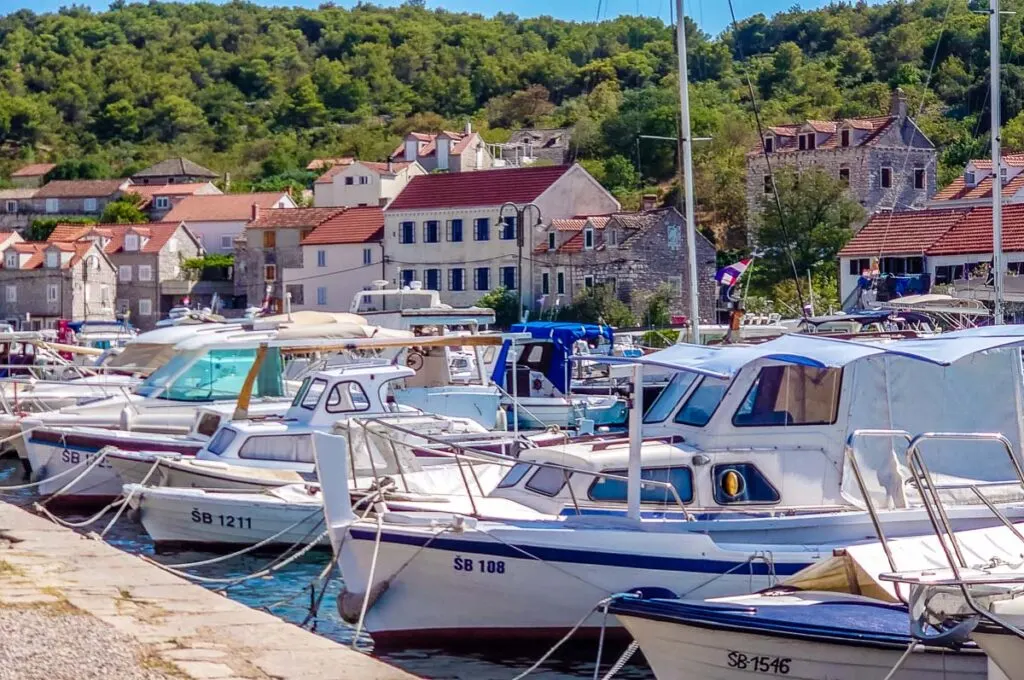
Preserving stories of coral hunters and sea sponge divers, and dotted with vineyards and olive groves, the Šibenik Archipelago is a boat ride away from the charming Croatian city of Šibenik. Ferries and boats connect the mainland to the inhabited islands regularly throughout the day. All you need to reach them is a bit of spirit for adventure. And a ticket, of course!
A short distance away from terra firma you will find peaceful insular lands where time seems to stand still, people are few and far between, and the sea sparkles under the golden rays of the Dalmatian sun. It’s a place where if you ask a local ‘Where is the nearest beach, please?’, they will tell you: ‘The whole island is a beach!’.
And if you bring a snorkelling mask, you can spend happy moments floating in the water and observing the colourful Adriatic fish dart above the pebbly seabed where spiky sea urchins huddle between rocks. So, better bring a pair of water shoes, too!
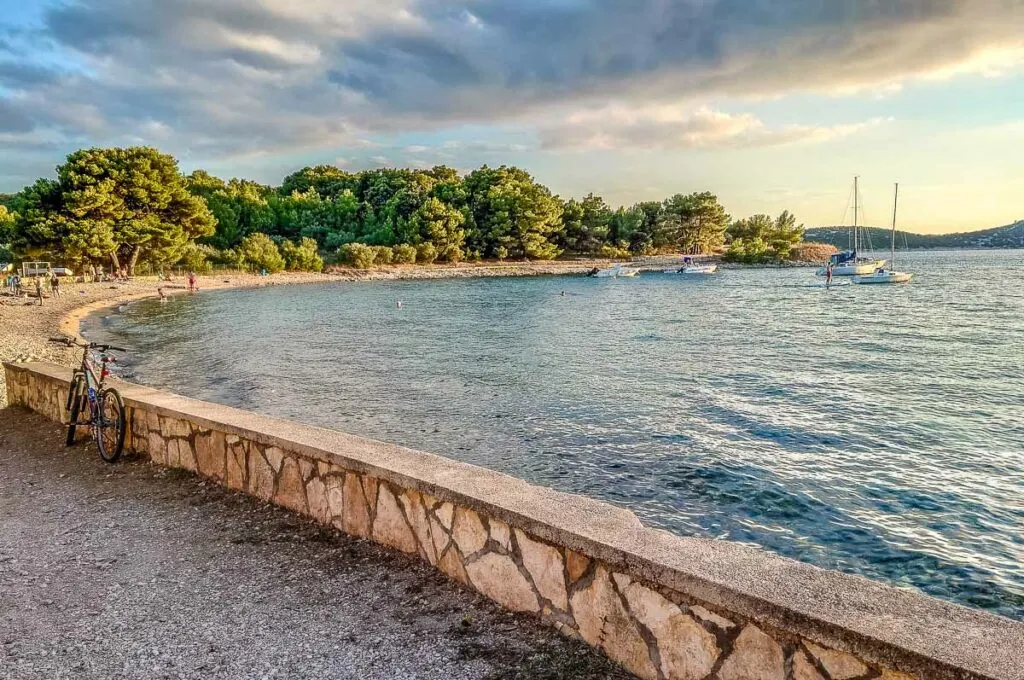
If you had never heard of the Šibenik Archipelago before today, that’s absolutely fine. Most people haven’t. I also hadn’t heard of it before my visit to Croatia this summer. Our initial plan was to visit Krka – Croatia’s nature park famous for its series of large waterfalls and picturesque ponds. As Šibenik was the closest city to the park, we decided to choose it as our base in the country.
In the weeks before we travelled there, I started searching for more information about the city and the things we could do in its surroundings. This is when I first saw a mention of the Šibenik Archipelago. And while we did visit Krka during our stay, it was this group of islands that actually stole our hearts in Croatia.
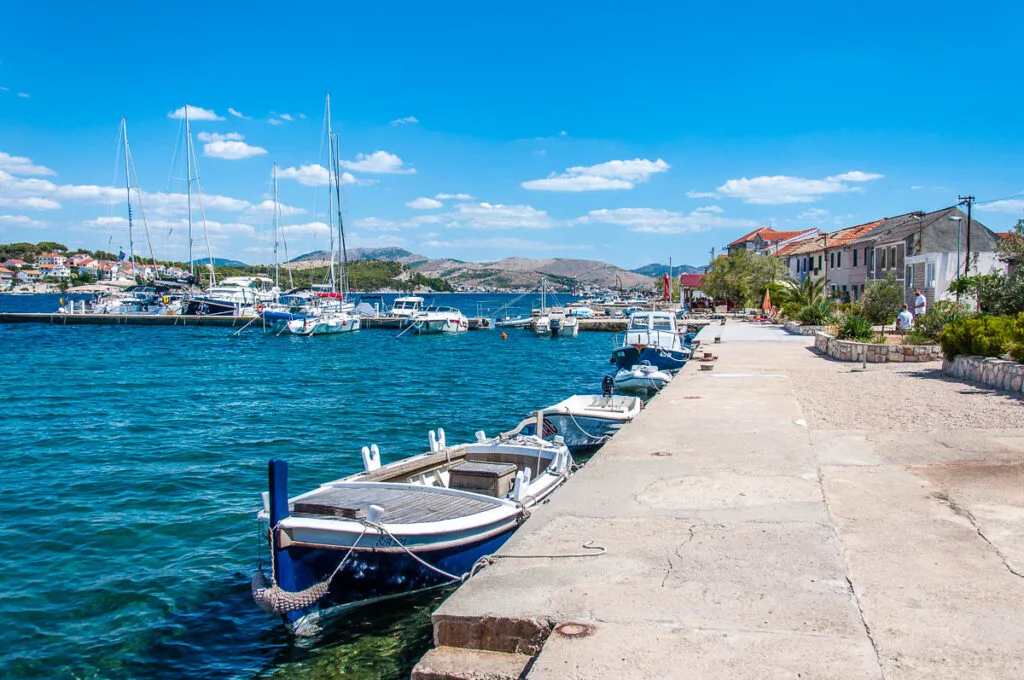
So, today, I want to tell you all that I learned about the Šibenik Archipelago – a cluster of insular pieces of land in a country famous for its islands. From what makes it so special to how to get to it and what to do on its islands, it’s all included here below in easy-to-browse sections.
I hope that all this first-hand tried and tested information will plant a little seed in your heart to go out there and see this little-known yet so charming corner of Southeastern Europe for yourself. This, after all, is a place where peace and quiet rule and where the stress and expectations of our modern lives seem a world away.
Have a look!
Island Hopping in Croatia’s Šibenik Archipelago – Best Things to Do, Eat, and Enjoy
Pin for Later!
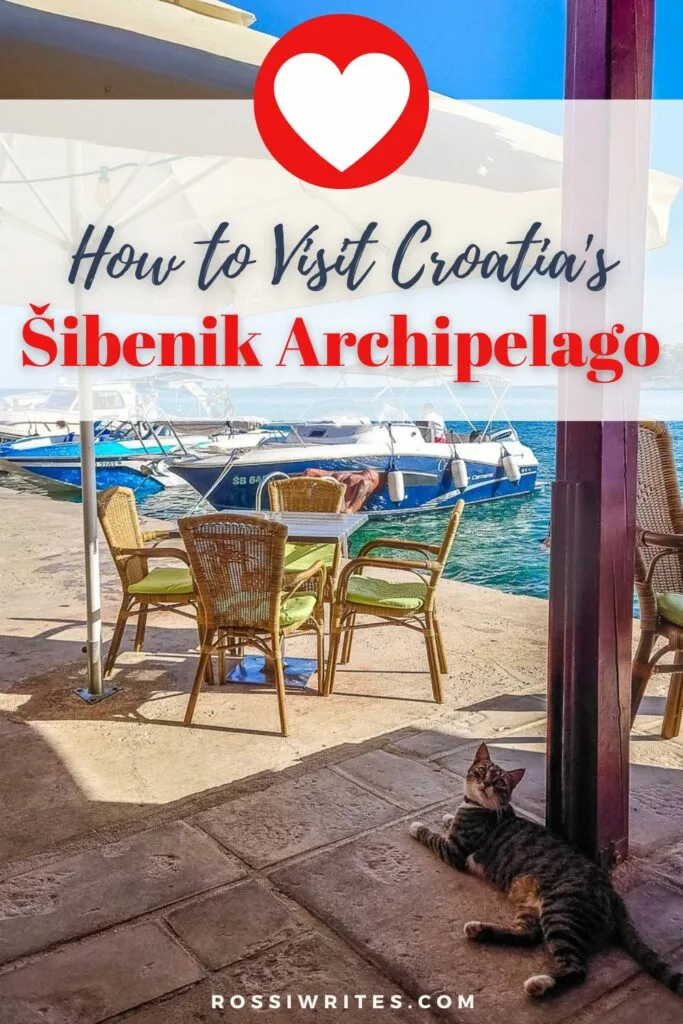

Where in Croatia is the Šibenik Archipelago?
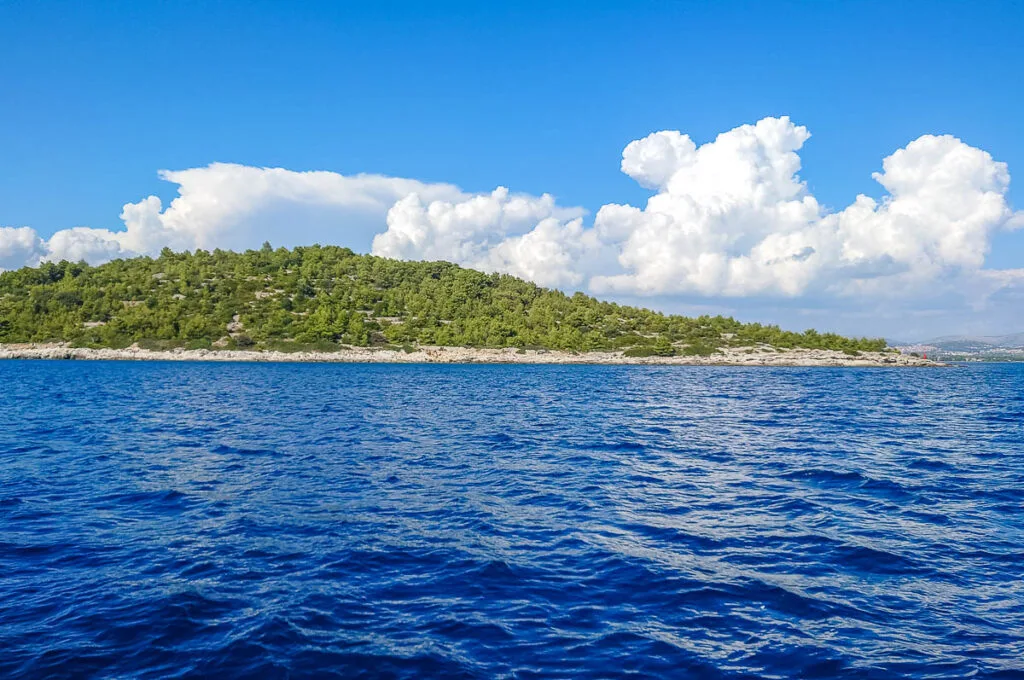
Croatia has 1246 islands, islets and rocks in the Adriatic Sea. 249 – or exactly one-fifth of them – belong to the Šibenik Archipelago. Yet, while many have heard of the Kornati Archipelago, its Šibenik counterpart remains largely unknown beyond the confines of Croatia.
The Kornati Archipelago is uninhabited and has a striking lunar landscape. A large portion of it is part of a national park and as such, tourist trips to its many islands are heavily promoted.
Many people travel to Croatia specifically to see the Kornati Islands while less than ten nautical miles away from them and very easily accessible from the city of Šibenik, stands the beautiful Šibenik Archipelago. The latter is not only very straightforward to reach independently by public transport but also has a rich palette of local traditions, pristine nature, and dozens of beaches.
You will find the Šibenik Archipelago in the heart of Croatia’s Dalmatian Coast. It’s named after the city of Šibenik – the third-largest city in the historic Croatian region of Dalmatia.
The six inhabited islands of the Šibenik Archipelago are Krapanj, Zlarin, Prvić, Murter, Kaprije, and Žirje. Another island here – Obonjan – houses a private resort.
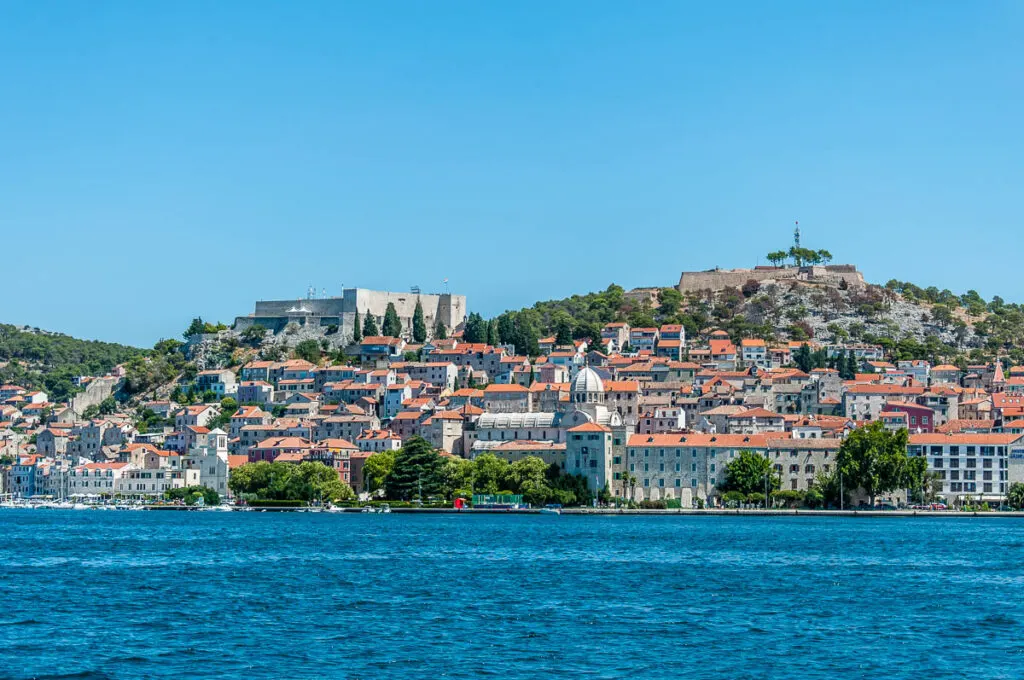
Šibenik (pictured above) is a city built in an enclosed bay. A narrow strait – the St. Anthony’s Channel – connects it to the Adriatic Sea. The islands of Zlarin and Prvić stand side by side right after the meeting point of the strait and the open sea. The tiny island of Krapanj is southeast of Zlarin and Murter is northwest of Prvić. The two outer islands – Kaprije and Žirje – are deeper into the Adriatic in a straight line from Prvić.
Altogether, around 7,000 people live permanently on the six inhabited islands. Murter is the largest island of the Šibenik Archipelago. Krapanj is the smallest inhabited island in all of Croatia.
Here is a useful map showing the location of the Šibenik Archipelago, the city of Šibenik, and the Kornati Islands. You can zoom in and out to get a better idea of their geographical position in the heart of the Dalmatian Coast. If you click on the grey star next to the map’s name, this will add the map to your account in Google Maps. This way, you can consult it as and when you want.
Here are the locations pinned to the map:
City of Šibenik – with red pin
Islands in the Šibenik Archipelago: 1. Krapanj 2. Zlarin 3. Prvić 4. Murter 5. Kaprije 6. Žirje 7. Obojnan – with green pin
Kornati National Park – with violet-blue pin
What Makes the Islands in Croatia’s Šibenik Archipelago a Must-See Place?
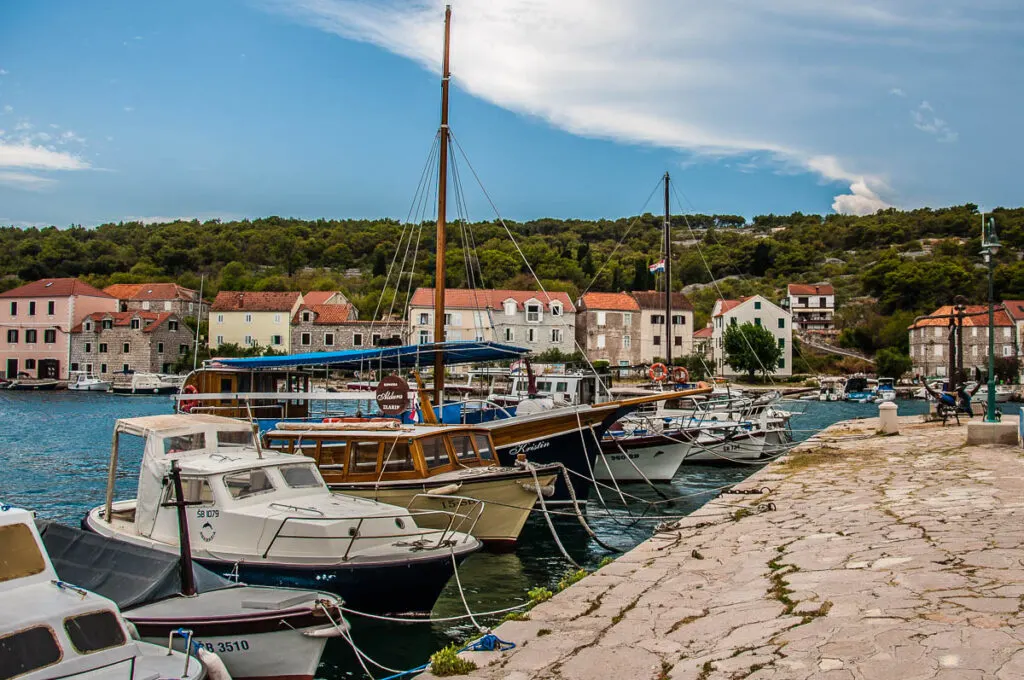
The Šibenik Archipelago remains little-known beyond the confines of Dalmatia and Croatia. Its islands – both inhabited and uninhabited – attract sailing enthusiasts. Many local people also spend their holidays in Krapanj, Zlarin, and Prvić. Murter is famous for its festivals and lively beaches.
Yet, the Šibenik Archipelago is undiscovered by the mass tourist. Here you can enjoy a swim in pristine waters with not a person in sight. The islands’ small villages take a long nap each afternoon. Flanked by tall stone houses, their streets reveal glimpses of daily life – a carefully tended vegetable patch in a front yard and long clotheslines with freshly laundered sheets and tablecloths flapping in the wind.
Being here is experiencing peace and quiet at a level that has been forgotten for decades in the large Western European cities.
Even more interestingly, each of the six inhabited islands of the Šibenik Archipelago has its own story to tell. This makes them unique destinations to explore. A visit to them will reveal a different little-known world to you full of local legends, customs, and beliefs. Not to mention that most of them are car-free! Here they are:
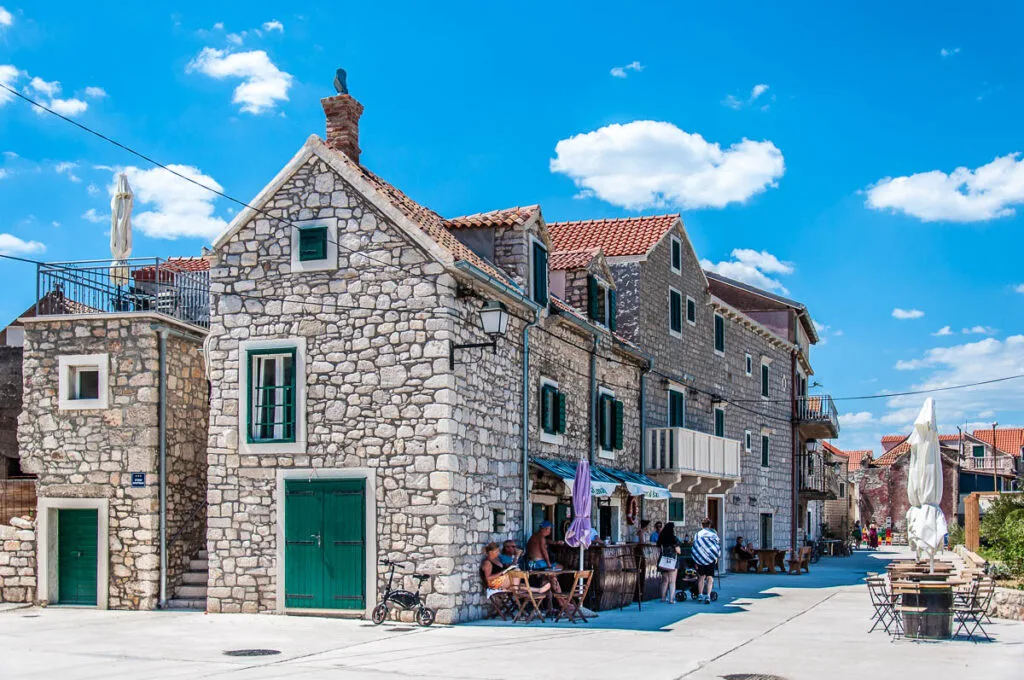
Krapanj – this tiny island is only 300 m away from the mainland. A ferry trip to it takes less than five minutes. Since the 17th century, this island in the Šibenik Archipelago has been known for its sea sponge hunters. To this day, the men of Krapanj dive to gather sea sponges in the Adriatic. Often, they venture up to 100 m deep.
You can literally trace the development of diving equipment by delving into the history of Krapanj. Visiting the sea sponge shops and the diving museums on the island is a wonderful way to meet face-to-face the descendants of the local diving families.
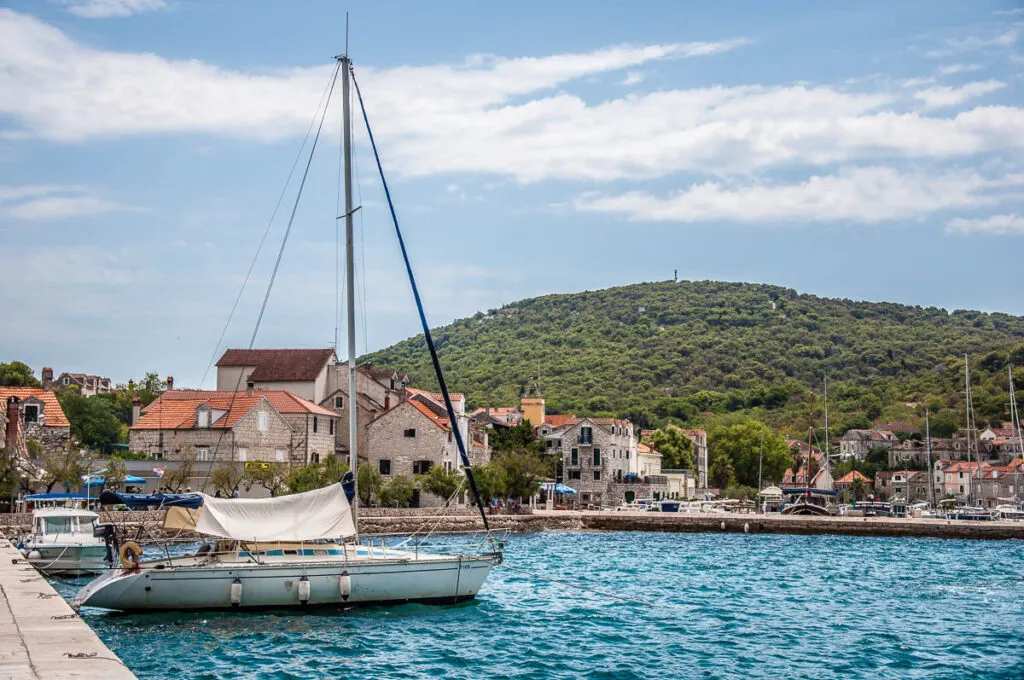
Zlarin – known as the Golden Island, it has been inhabited since Illyrian and Roman times. The island’s one village can trace its roots back to the 13th century.
Zlarin is known for its coral-hunting traditions. A rich tapestry of local customs has evolved over the centuries around the men who dived up to 200 m to collect corals from the seabed. To this day, the inhabitants of Zlarin believe that red corals are a symbol of loyalty, fidelity, and obedience. They also protect the wearer. Especially, pregnant women.
A large Coral Museum is being outfitted on the island to preserve the community’s memory by telling stories that have never before been put to paper.
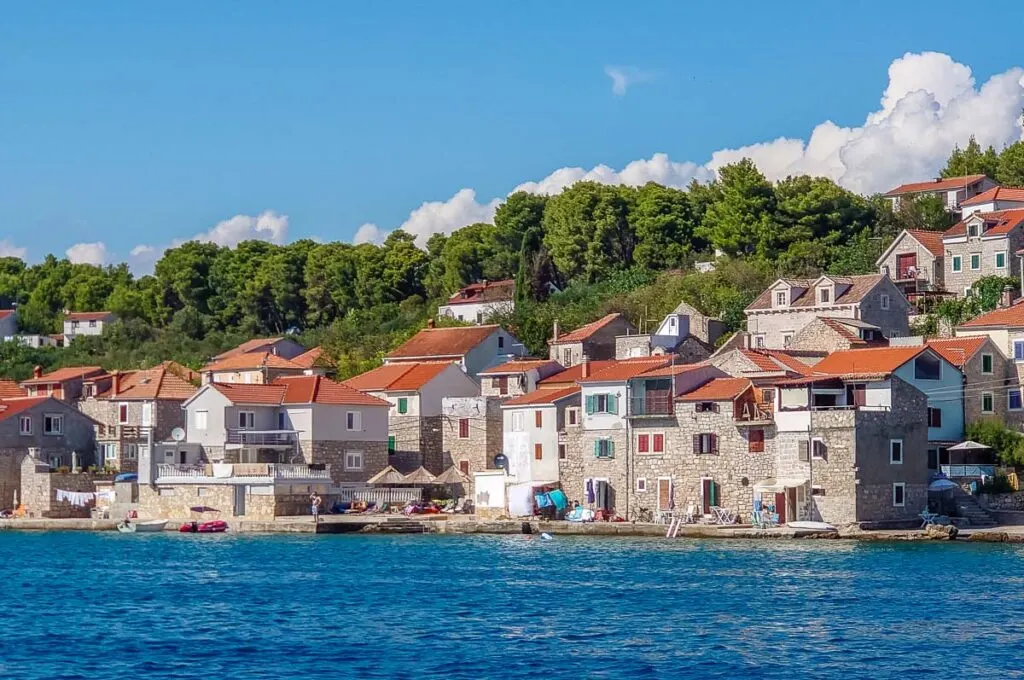
Prvić – With two small villages – Prvić Luka and Šepurine – connected by a wide path, this island is so very peaceful and picturesque. Vineyards are planted on its hilly sides and the local restaurants serve delicious Dalmatian dishes and homemade ice cream.
This small island in the Šibenik Archipelago was instrumental in the story of one of the most notable Croatians – Faust Vrančić (also known under his Italianised name, Fausto Veranzio). He was a 17th-century polymath and excelled as a scientist, historian, linguist, philosopher, mathematician and physicist.
As a child, Vrančić spent many summers on Prvić. He is buried on the island and a large Memorial Centre nowadays stands in Prvić Luka telling the story of his life and his many inventions. Among them is the Homo Volans – one of the very first prototypes of the parachute.
Murter – here you can explore the Betina Museum of Wooden Shipbuilding and spend time on one of several very popular beaches. Nightlife in Murter, unlike the other islands in the Šibenik Archipelago, is rather lively. With its four towns and numerous cafes and clubs, Murter attracts a younger crowd.
Kaprije – with a name that comes from the Croatian word for capers – kapare – this remote island in the Šibenik Archipelago has a population of only around 160 permanent residents. Grapes and olives grow here under the hot Croatian sun.
A kilometre and a half away from Kaprije stands the tiny uninhabited island of Bavljenac. The curious thing about it is that it’s covered with an ancient network of dry-stone walls that altogether are over 23 km long. The walls form a sort of maze that covers the whole island. In the past, they were used to outline the locals’ agricultural plots and to protect the land and the plants from the strong sea winds.
You can see similar networks of dry-stone walls on many of the islands in the Šibenik Archipelago. Bavljenac has the largest concentration of them and as such is also known as the Fingerprint Island and the Island of 1,000 walls.
Žirje – this is the furthest from the mainland permanently inhabited island in the Šibenik Archipelago. Only about 100 people live here year-round. With a name that comes from the Croatian word for acorn – žir – the island has vineyards, olive groves, and fruit orchards. Fish is also abundant and fishing is one of the main local occupations.
An outer island with a strategic location, Žirje was once a military base. When Croatia was part of former Yugoslavia, parts of the island were inaccessible to non-military personnel for decades.
Which Islands of the Šibenik Archipelago Are the Easiest to Visit?

For a trip to the islands in the Šibenik Archipelago, first you need to reach the city of Šibenik on the Dalmatian Coast in Croatia. There are two nearby airports:
- Split Airport – 60 km away; and
- Zadar Airport – 75 km away.
A dense network of local buses connects the main cities and towns in the historic Croatian region of Dalmatia. Alternatively, you can rent a car.
Once in Šibenik, the inhabited islands in the Šibenik Archipelago are very easy to visit either by ferry and/or bus. Here is how to proceed:
By Ferry:
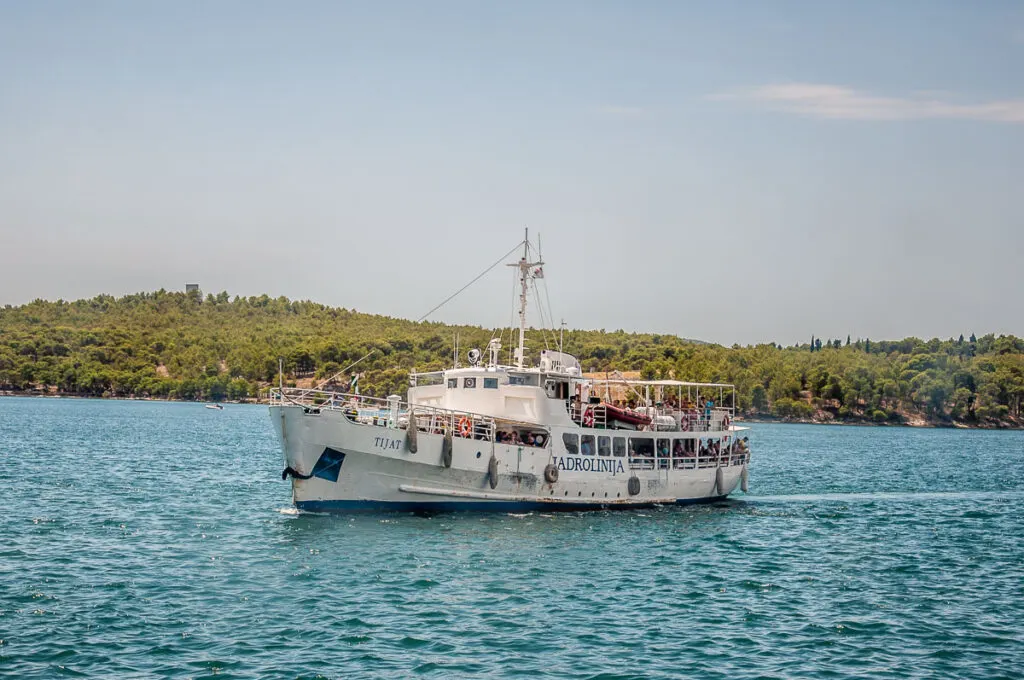
The Croatian sea shipping company Jadrolinija provides ferry lines which connect the following islands and mainland cities at regular intervals throughout the day:
Šibenik – Zlarin – Prvić Luka – Šepurine – Vodice – where Prvić Luka and Šepurine are the two villages on the island of Prvić. Vodice is a popular coastal town and resort about 14 km away from Šibenik.
The crossing from Šibenik to Zlarin takes half an hour and the crossing from Zlarin to Prvić Luka takes 15 mins. You can walk from Prvić Luka to Šepurine in about 10-15 mins. The crossing from Šepurine back to Šibenik takes about an hour to an hour and ten minutes.
Šibenik – (Zlarin) – Kaprije – Žirje – where the crossing from Šibenik to Kaprije takes 1 h 10 mins (or longer if the ferry stops at Zlarin). The journey from Kaprije to Žirje is about 30 mins.
Bear in mind that there are fewer crossings on Sundays and holidays. Check Jadrolinija‘s official website for timetables and prices.
By Bus and Ferry:
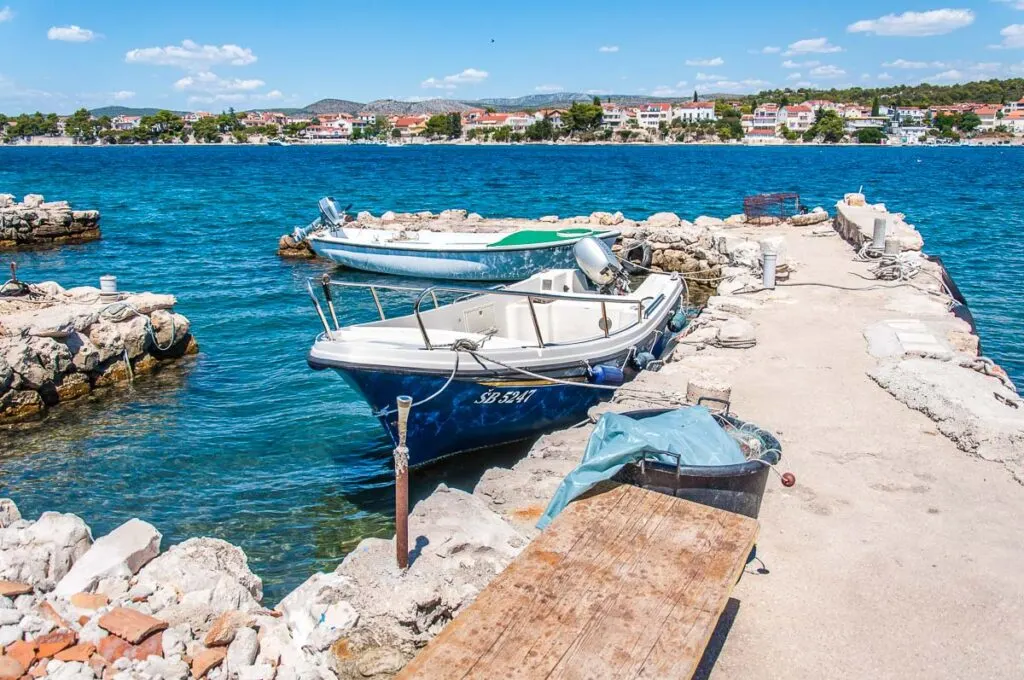
To reach Krapanj, first, you need to take a bus from Šibenik to the village of Brodarica about 8 km away from the city. The journey lasts around ten minutes on average. You can use Omio or Bus Radar to research buses from Šibenik to Brodarica.
The buses leave from the local coach station called Avtobusni Kolodvor (address: Draga 14, 22000 Šibenik) in Croatian. Then, there are numerous ferries that make the crossing from Brodarica to the tiny island of Krapanj in less than five minutes.
Alternatively, take a taxi or a Uber to Brodarica. It cost us about 80 kuna (the Croatian currency with one British pound converting to roughly seven to eight kuna) on a Sunday when the number of buses and ferries is reduced.
If you don’t want to wait for the ferry in Brodarica, there are also a couple of private taxi boats which take passengers to the island of Krapanj and back. They charged us eight kuna per person.
By Bus:
The island of Murter is connected to the mainland by a drawbridge. To reach it, you need to take a bus from Šibenik. The buses leave from the local coach station called Avtobusni Kolodvor (address: Draga 14, 22000 Šibenik). You can use Omio or Bus Radar to research buses to Murter and the towns on it – Murter, Betina, Tisno, and Jezera.
What to Do on the Main Islands of the Šibenik Archipelago?
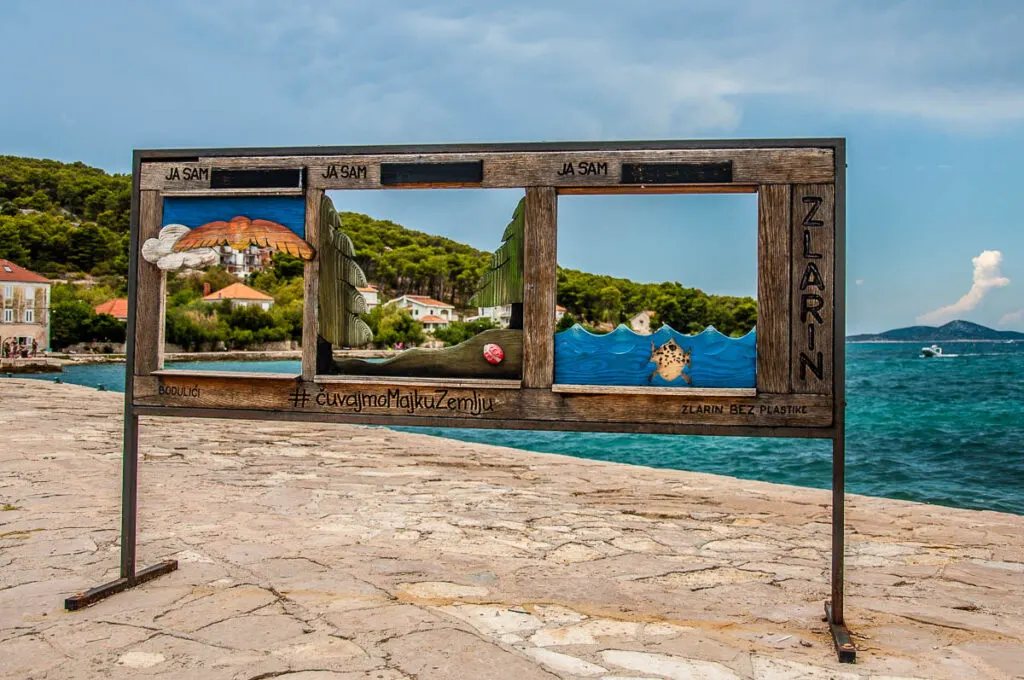
Don’t expect long lists of things to do on the islands of the Šibenik Archipelago. Most of them like Zlarin, Krapanj, and Prvić have centuries-old churches and monasteries, one or a couple of small museums, several hiking paths, numerous coves and places to have a refreshing dip in the Adriatic Sea.
Prvić also has the splendid Memorial Centre dedicated to the polymath Faust Vrančić. And Zlarin has the soon-to-be-opened, brand-new Coral Museum. We saw the finishing touches being put to its large building when we visited the island in July 2022. It promises to be splendid.
Apart from these sights, visiting the islands of the Šibenik Archipelago is mostly about being present in the moment and enjoying the pristine nature and the peace and quiet of these undiscovered by mass tourists places.
Hike, swim, and eat in the local taverns (called konoba in Croatian). Enjoy the sun and the sea. Sit on the upper deck of the ferry taking you around the islands and let the wind ruffle your hair. Do the walk between the two villages on the island of Prvić. Marvel at the endless lines of dry-stone walls that crisscross the islands. Hike to the top of Zlarin’s highest hill. At a height of only 169 m, Klepac affords spectacular views over the Adriatic Sea.
If you are lucky to visit the islands during one of their cultural evenings or festivals, then you will see the locals either in traditional local folk dress reliving their past or enjoying theatrical performances, music concerts, and various workshops. This is when hundreds of people may flock to a particular island turning it momentarily into a lively hub. The Farewell to Coral Hunters, the Zlarin Street Music Festival, and the Zlarin Outdoor Festival are among the main events. In summer, the island of Zlarin even organises a hotly contested fish stew competition.
In general, however, if you are looking for a place with things to do, do, do and keep you busy all day long, then leave the Šibenik Archipelago for some other period in your life. If you are seeking silence and peace and take pleasure in simply sitting down to enjoy a great meal or to see a splendid sunset, then the islands of this hidden gem of a Croatian archipelago may be just what you are looking for.
Where to Stay in the Šibenik Archipelago?
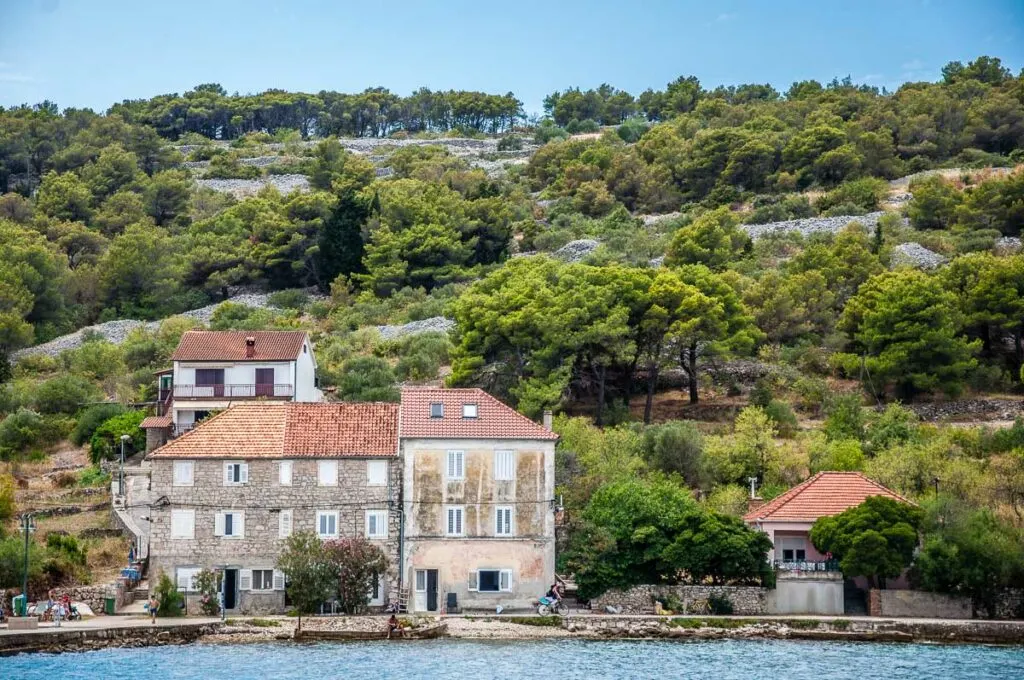
If you are planning to stay on an island in the Šibenik Archipelago for a few days, the best thing is to book your accommodation in advance.
There aren’t many hotels here and most places to stay are private homes and guesthouses. The islands welcome a healthy number of return visitors every high season who book the same accommodation in advance year after year.
In fact, when on Zlarin, we popped into the local tourist office to ask about various things. One of the questions was: ‘If we miss the evening ferry back to Šibenik, is there a place to stay overnight?’.
This is when we were kindly advised that most people travel to the Šibenik Archipelago to spend at least a week and finding a room at the last moment and just for one night is not easy. So, if you want to visit and stay, it’s best to come with a booking already made.
I usually prefer to book all my accommodation through Booking.com. Click to see all available options for Krapanj, Zlarin, Prvić Luka, Prvić Šepurine, Murter, Kaprije, and Žirje. Alternatively, you may want to stay in the private resort on the uninhabited island of Obonjan.
If you need some visual help in terms of precise location and price range, have a look at this map. It gives you a quick idea of the prices and whereabouts of the hotels, guesthouses, and other forms of accommodation you can book for your stay in the Šibenik Archipelago in the historic Croatian region of Dalmatia.
You can zoom in and out in order to search for a place to stay. You can also click on the option that interests you to find out more details or to make a booking directly.
Booking.comWhat to Eat in the Šibenik Archipelago?
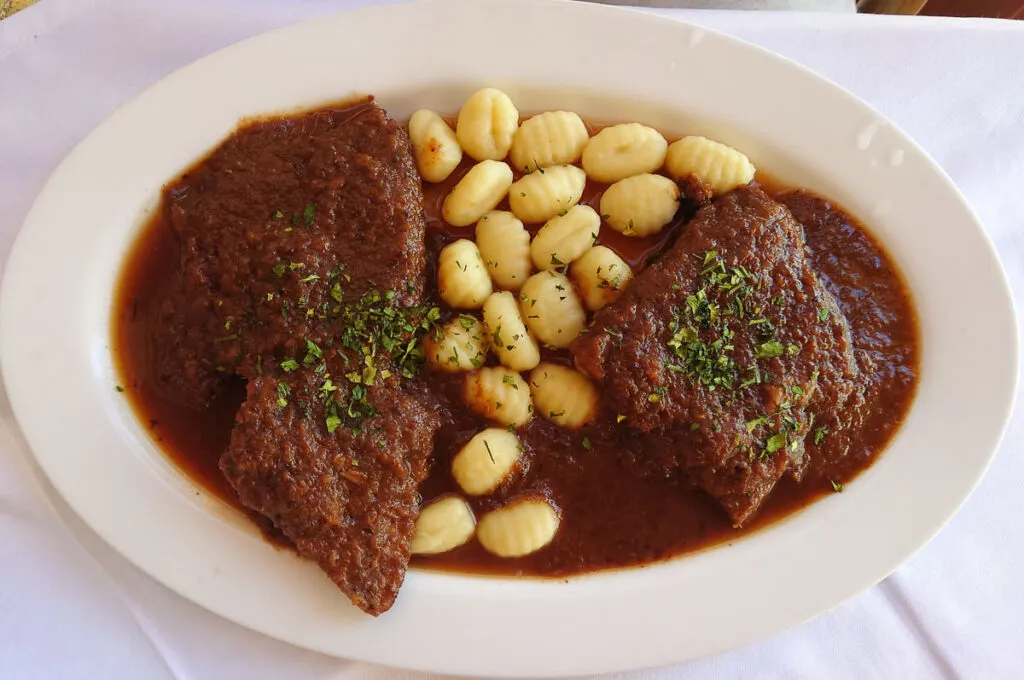
Use your time on the islands of the Šibenik Archipelago to tuck into many Dalmatian specialities. The local octopus stew comes highly recommended. If you prefer meat, give pašticada a try. This is slow-cooked beef served in rich sweet and sour sauce and garnished with gnocchi.
Other local options are squid ink risotto, seafood risotto, fish stew (brudet), and fried sprat (girice). Salads are delicious and can be seafood- or meat-based or vegetarian.
Finish off with a rožata (thick and more-ish creme caramel) and/or scoop of locally made ice cream.
How Many Islands of the Šibenik Archipelago Can I See in a Day or Two?
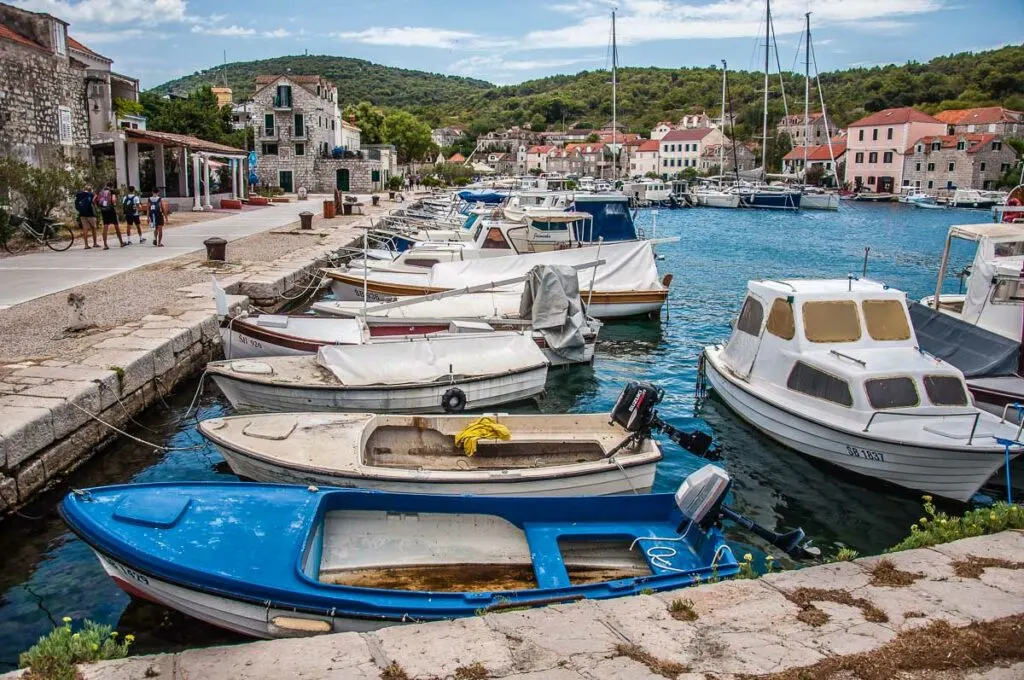
In a day, you can easily see from one to three islands by public transport. Over two days, you can see two to four islands. It depends on which islands you want to visit and how you organise your time in the area.
It also depends on the current ferry and bus timetables. In July and August, there are more ferry crossings than in June and September. Also, on Sundays and public holidays, there are fewer ferry crossings than during the week. Finally, the outer islands of Kaprije, and Žirje get only one or two ferry crossings per day.
The best thing is to always check the current ferry timetable on the official website of Jadrolinija as soon as you know your exact dates of travel to Šibenik and Croatia.
You can easily spend a whole day at each island, just taking it easy, looking around, sunbathing, swimming, and even doing a short hike or two. Murter, for being the largest island and further away from the other five is perfect for a day-long exploration.
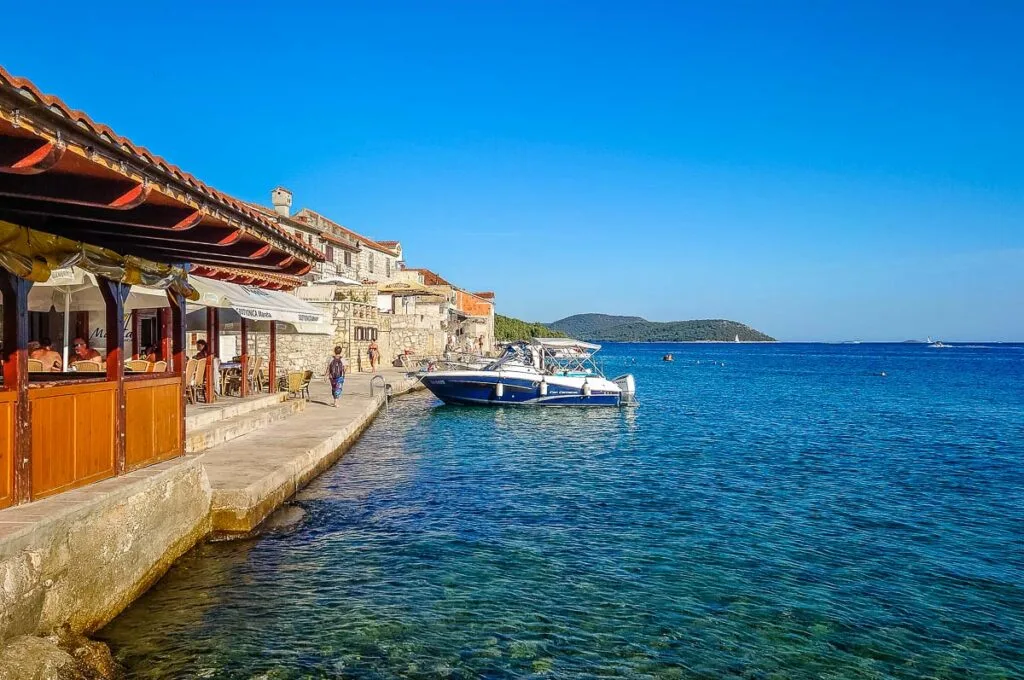
Otherwise, here are a few potential scenarios:
1. Krapanj in the morning and Zlarin (and, potentially, Prvić) in the afternoon – this is one of the busiest and most time-pressing options. In the morning, catch the first bus (or better get a taxi) to Brodarica and then the first ferry or water taxi to Krapanj. Return to Šibenik at lunchtime and catch the ferry to Zlarin. In the late afternoon, either return to Šibenik or catch the ferry across to Prvić Luka. Walk across the island to Šepurine and get the last ferry back to Šibenik. This also works well over two days with Krapanj on one day and Zlarin and Prvić on the following day or vice-versa.
2. Zlarin in the morning and Prvić in the afternoon – this is the easiest option. Get the ferry from Šibenik in the morning. Spend some relaxing hours in Zlarin. At lunchtime, catch the ferry to Prvić Luka. Walk across the island to Šepurine and get the return ferry to Šibenik.
3. Krapanj one day and Murter the next day or vice-versa – use the local buses to get to the village of Brodarica and once there get the ferry to Krapanj. The day after, get the bus to Murter and explore its four small towns.
4. Murter one day and Zlarin and Prvić the next day or vice-versa – use the local bus to get to the island of Murter and spend the day there exploring its beaches and towns. The day after, get the ferry to Zlarin. At lunchtime, ferry-hop over to Prvić and explore its two villages on foot.
If you are pressed for time and don’t want to depend on the ferry and bus timetables, then you can book an organised tour of the Šibenik Archipelago. This one, will help you explore Zlarin, Prvić, and the uninhabited island of Tijat in six hours.
What to Pack for a Visit to the Islands in Croatia’s Šibenik Archipelago?
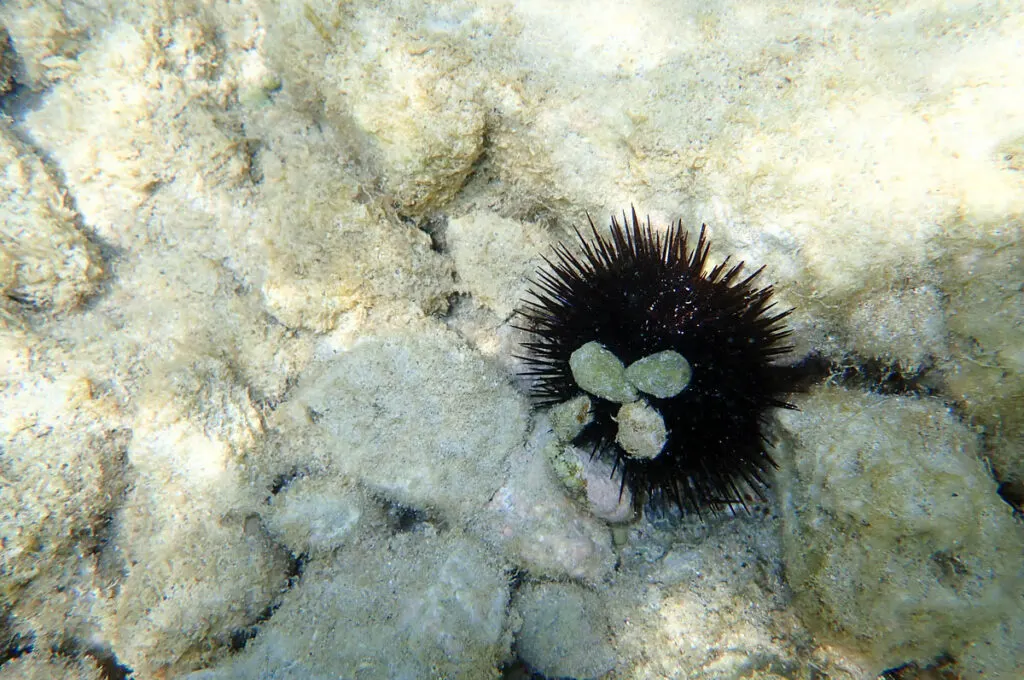
The most important item to put in your luggage is a pair of comfortable shoes. You will be spending lots of your time here on your feet and you want your feet to feel comfy and protected no matter if you decide to do a last-minute hike or beach hop around an island or two.
Next, don’t forget the water shoes. Croatian beaches are customarily pebbly with lots of sharp rocks. Not forgetting the cute but oh-so-spikey sea urchins hiding in clusters between the stones. You wouldn’t want to step on one! It hurts!
Bring light, easy-to-dry clothes and a bathing suit. A large towel, high-factor suncream, and a sunhat. If you are planning to catch the late ferry, pack something light to drape around your shoulders in the evening. It can get very windy on the upper deck.
Card payments are accepted in the local restaurants and shops. Still, bring some cash to be on the safe side. I saw an ATM on Zlarin and most probably there is one or two on the other islands, too. We met a French family who complained that they got charged 40 euros every time they tried to take cash out from an ATM in Croatia.
This sounded mad until our last day in the country when I tried to take 20 pounds worth of kuna for a last-minute purchase and the bank fee was close to four pounds! We had bought Croatian kunas in England before travelling to Šibenik. The exchange rate was much better than the ones we later saw offered in Croatia. Also, our banks didn’t charge us for using our cards abroad and gave us a very good exchange rate. When it came to taking cash out of an ATM though, it was a completely different story.
What to Know Before Visiting the Šibenik Archipelago?
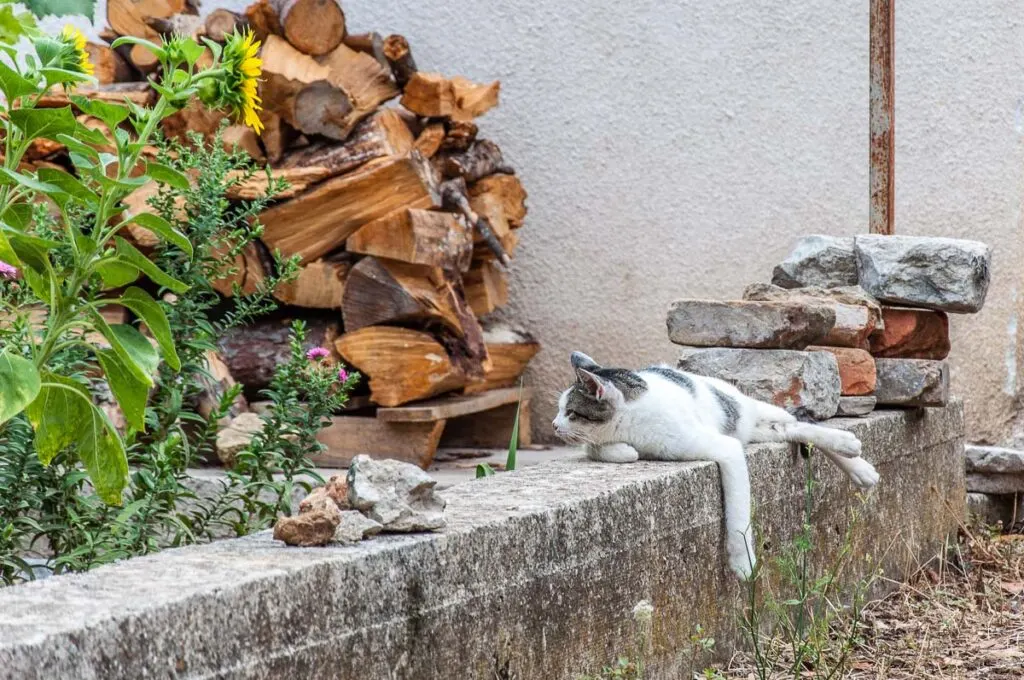
The most important thing to know in advance is that the inhabited islands of the Šibenik Archipelago are very easy to reach by public transport. They are wonderful day trips from the city of Šibenik and even from nearby Split and Zadar in the historic Croatian region of Dalmatia.
All the people we spoke to at the city of Šibenik’s coach station and the adjacent ticket office for the ferries spoke English. It was very easy to get the information that we needed.
Very close to the popular Kornati Islands, the Šibenik Archipelago remains very much a hidden gem. It would appeal to lovers of peace and quiet, to people who want to relax, and to travellers seeking to explore secret corners of Europe. The islands are not flashy and are instead very laid-back. You can tell that nothing much happens here but then again they offer the perfect antidote to breathless sightseeing and constant exploration.
The local houses are traditionally made of stone and the promenades are made of cement. Front yards vary from beautifully presented to a mish-mash of vegetable patches, bushes, and laundry pegged to dry in the sun. Krapanj, Zlarin, Prvić, and Kaprije are car-free. You may see the occasional golf cart.
In the Šibenik Archipelago, you can relax, take it very easy, and even enjoy an afternoon nap. Time stands still there in the most calming way.
When Is the Best Time to Visit the Šibenik Archipelago in Croatia?
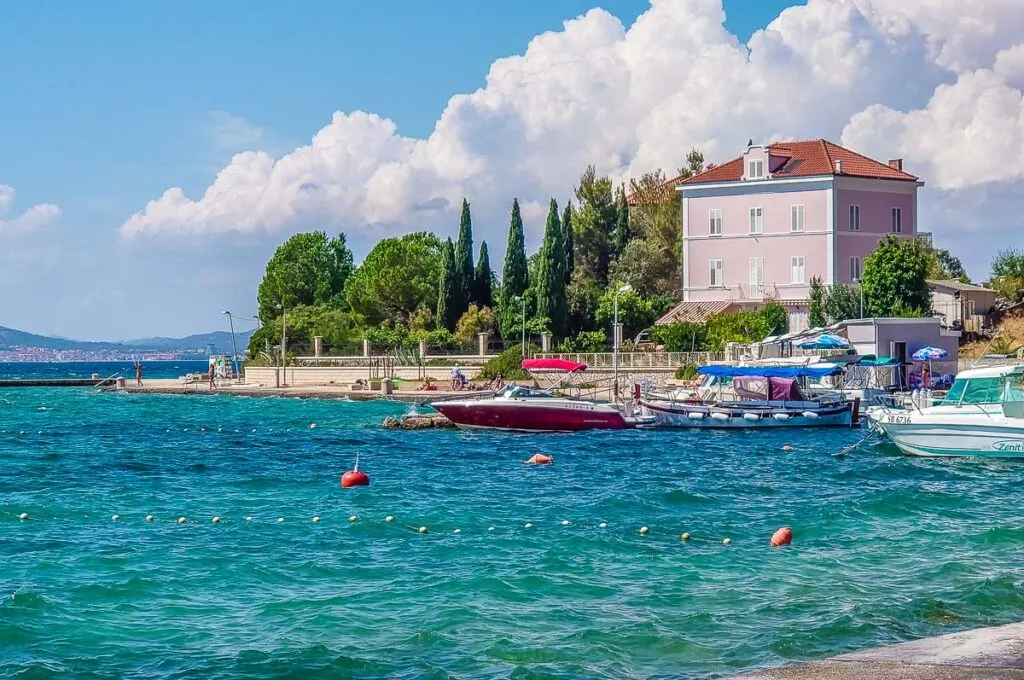
The best time to visit the Šibenik Archipelago for me, at least, is during the high season.
Ferry-hoping around the islands (or sailing, if you have a yacht at your disposal) is a great way to catch a bit of a breeze on a hot day in Dalmatia. A swim in the warm waters of the Adriatic Sea is another way to cool off and enjoy the beauty of the islands’ pristine nature.
During the high season, the Šibenik Archipelago also offers the most in terms of accommodation options and restaurants and taverns. The rest of the year, the permanent population here shrinks so there is reduced availability of services.
How Long to Spend on the Islands of the Šibenik Archipelago?
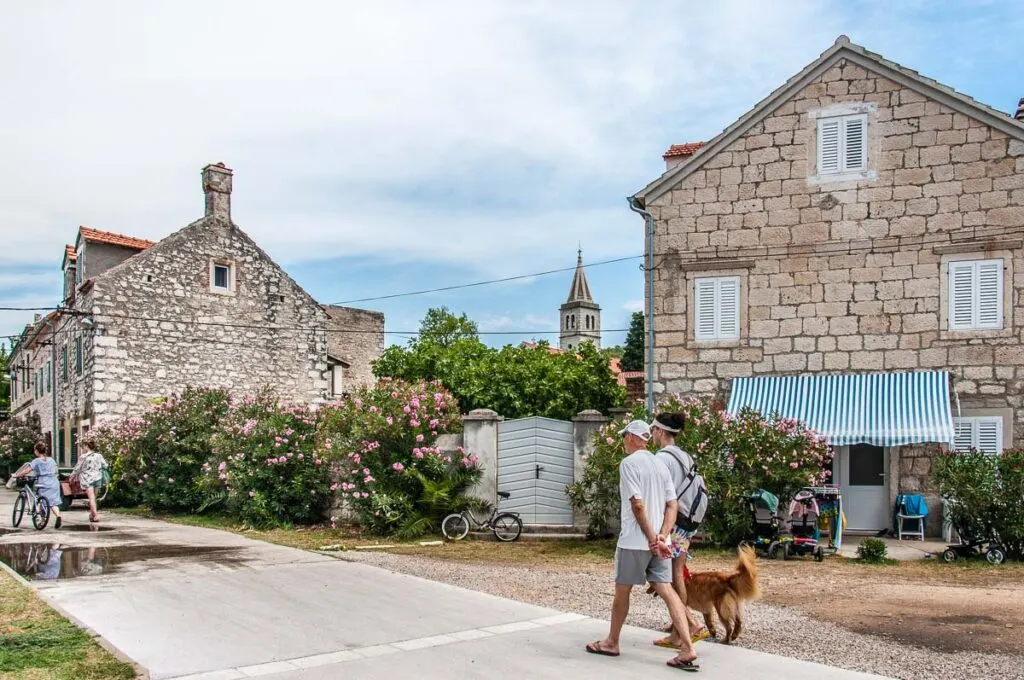
Try to dedicate at least a day, ideally two to the Šibenik Archipelago. It’s one of the very best things to do near the city of Šibenik in particular and in the whole of Dalmatia in general.
If you are looking for peace and quiet or to explore a still little-known corner of Europe, then you can book to stay a week. I can imagine the islands as a perfect base for writers and artists to retreat to in order to write and create undisturbed.
What Else to See in This Corner of Croatia?
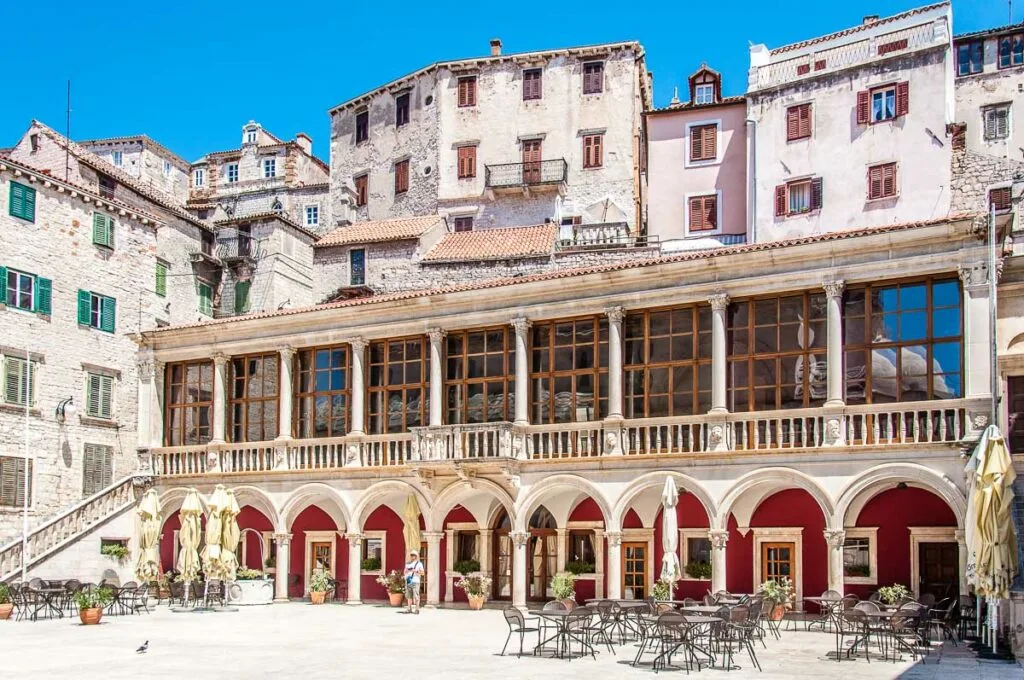
The Šibenik Archipelago is one of the best things to see in the heart of the Dalmatian coast of Croatia. In addition, there are several other must-see places nearby to put on your bucket list. Here they are:
Šibenik – a splendid Dalmatian city with two UNESCO World Heritage Sites. Connected by ferry and bus to the islands, it has a beautifully preserved medieval nucleus and a host of unmissable landmarks. Among them stands out the Cathedral of St. James – the most important Renaissance building in the whole of Croatia.
This is, actually, the city where we spent most of our week in Croatia this summer, so I can wholeheartedly recommend Šibenik. It’s lovely on many levels!
Krka National Park – just seven km away from Šibenik, this is a huge nature park with numerous lakes and a series of seven waterfalls. A beautiful, idyllic place where you can walk through lush forest, marvel at huge waterfalls and take a boat for a peaceful, soul-inspiring trip to the island monastery of Visovac. This organised tour gives you a chance to easily visit Krka and Šibenik from the nearby town of Trogir in one day.
Kornati Islands – this is the largest and densest archipelago in the Adriatic Sea. It consists of 140 islands and islets and it’s completely uninhabited. 89 of its islands are part of the Kornati National Park – a protected territory with crystal-clear waters and rich underwater life. Many organised tours take tourists from Šibenik and the surrounding area to the Kornati Islands. This one comes highly recommended.
Primošten, Vodice, and Tribunj – picturesque small towns on the Dalmatian Coast. If you are after gorgeous little places with an authentic spirit in Croatia, these are the top destinations to consider visiting.
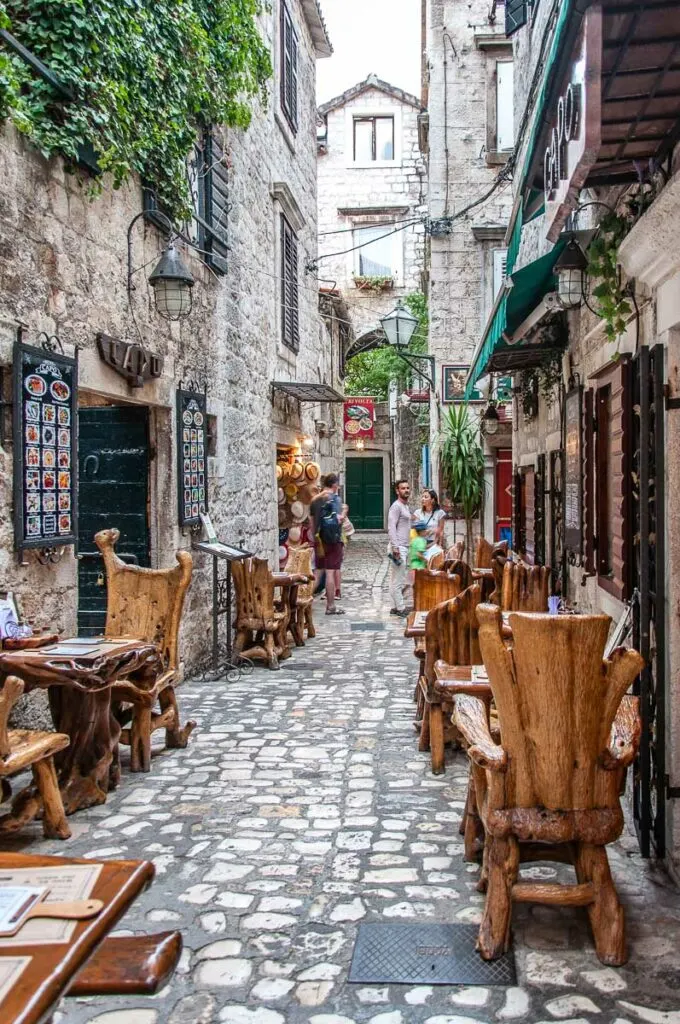
Trogir – a beautiful island town less than an hour away from Šibenik. Its Old Town is a UNESCO World Heritage Site. Find extensive information about it in my blog post: Trogir, Croatia – How to Visit and 15 Best Things to Do in the Town of Opportune Moments (With Maps and Practical Tips)
Split – Croatia’s second-largest city is about an hour away by highway and about an hour and a half away by coach from Šibenik. Among the many must-see things in Split, don’t miss the Diocletian Palace – one of the largest and most imposing ancient Roman structures to reach us to this day.
Zadar – just over an hour away from Šibenik, you can visit the oldest continuously inhabited Croatian city. Zadar has a lot to offer to the curious traveller. From Roman ruins and Venetian architecture to beautiful sandy beaches, you will be spoilt for choice.
My Personal Experience Island-Hopping in the Šibenik Archipelago in Croatia?
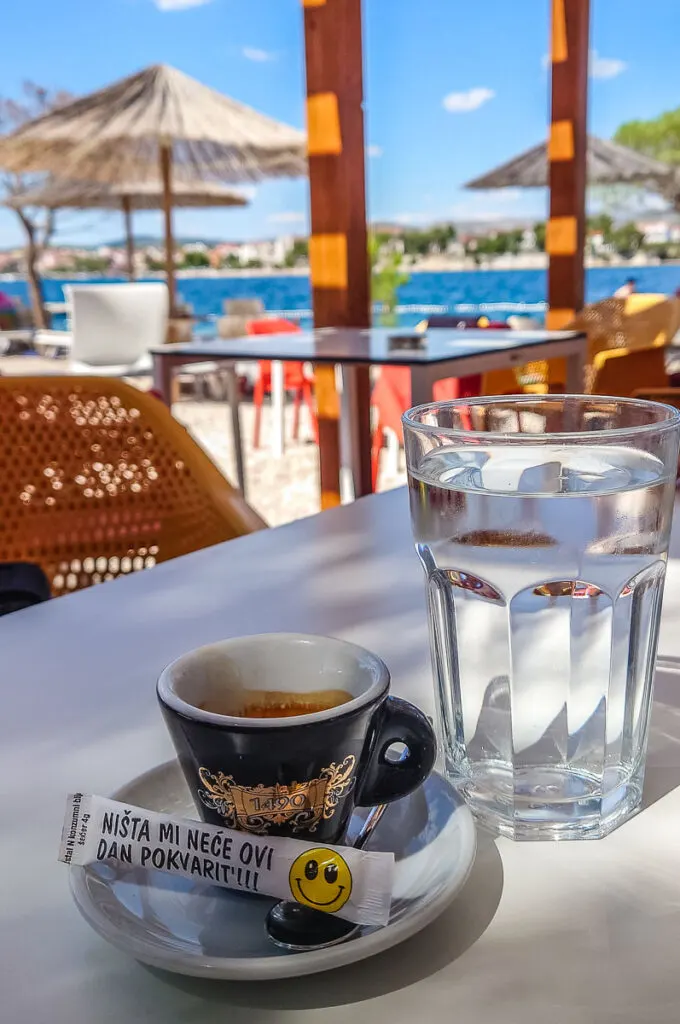
I really enjoyed discovering the Šibenik Archipelago for myself this summer in Croatia. My family – my husband, our daughter, and I – spent a week on the Dalmatian coast of this beautiful country between the end of July and the start of August.
It was our first proper summer holiday since the lockdowns started back in 2020. So, we were looking forward to it. At the same time, we didn’t know if it would happen at all as right around the date of our departure, the British newspapers were full of news about cancelled flights, people having to spend days queuing in airports, and general havoc in the travel business.
So, it was with great relief that we boarded our plane to Split without any issues or any signs of disorganisation at Luton Airport. Two hours and a half later we arrived. Right before landing, we had glimpsed chains of islands in the Adriatic Sea giving us a taster of the places we were to explore for ourselves over the forthcoming days.
After a night and a day in Trogir – a beautiful town on a small island – we headed to Šibenik – the third-largest Dalmatian city. This beautiful city with a stunning medieval centre of tall stone houses and narrow curving streets was to be our base for the week.
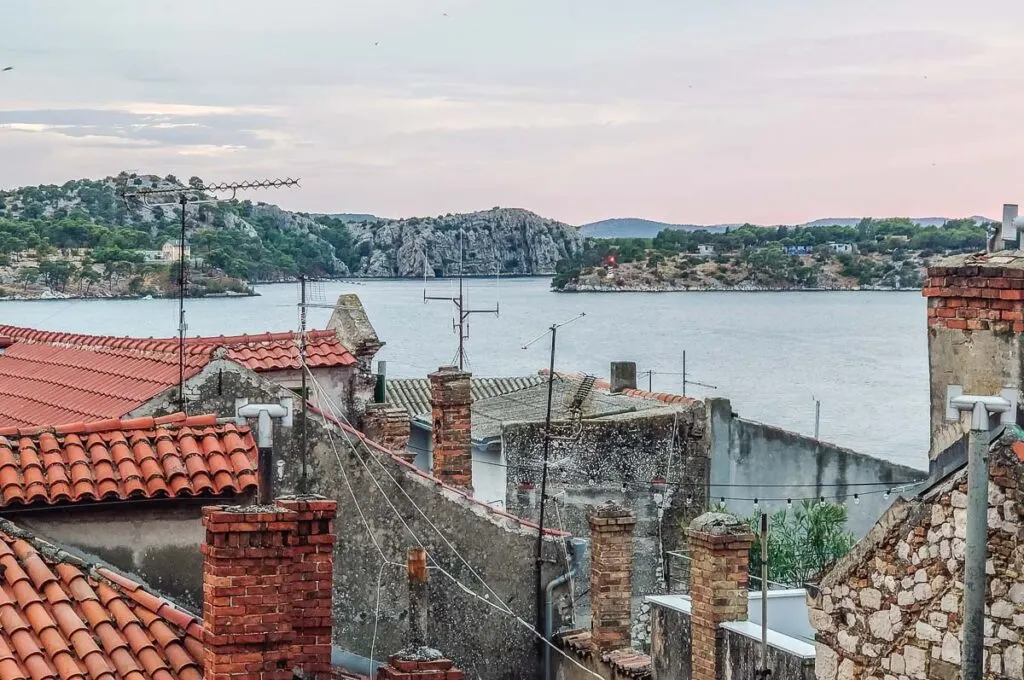
From the roof terrace of our accommodation – the lovely Apartments Andrea – we could see the whole enclosed bay of Šibenik. The strait that connects it to the Adriatic Sea – the St. Anthony Channel – was in a straight line right in front of us. Beyond it, in the falling dusk, we could see shapes – long islands surrounded by sparkling waters. This was the Šibenik Archipelago, which I already knew of from my research back home.
What I didn’t know however was how to get to it. The day after we popped into Šibenik’s tourist information office and got hold of the ferry’s timetable and lots of useful information about visiting the islands.
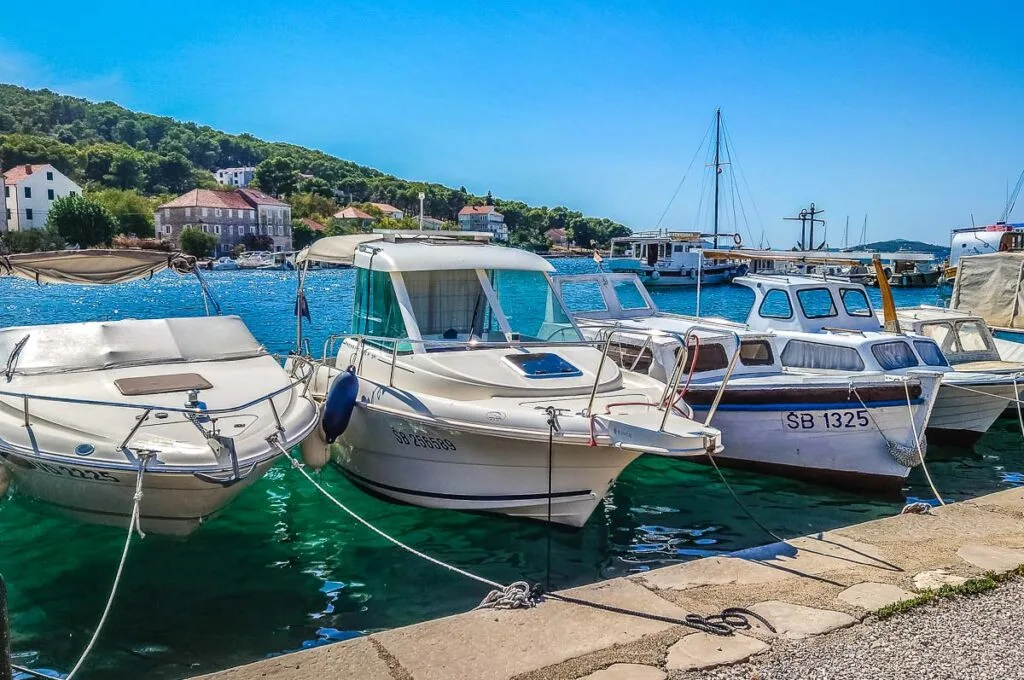
Our first destination was Zlarin – the Golden island – where red coral hunters have lived for centuries. It was so nice to be at a place where we didn’t have to rush from one sight to the next. We could simply walk around, swim in the crystal-clear waters, and just relax into the island.
In any case, before we headed to the beach, we went for a walk around Zlarin’s only village. It was well-appointed with beautiful stone houses and many boats and yachts in its harbour. We were eager to see the Coral Museum that had been mentioned in each leaflet we had gotten hold of. As it transpired, the museum was still being built, so we saw its large building in passing as people were putting the finishing touches to it.
Zlarin’s beaches are narrow and pebbly. Sea urchins hide in droves between the sharp rocks on the seafloor. Thankfully, we had our trusted Hot Tuna and Crocs with us. The incredibly see-through water was so worth it though. Warm and calm, it was a pleasure to simply float on top of it, a snorkelling mask on my eyes trying to spot darting colourful fish.
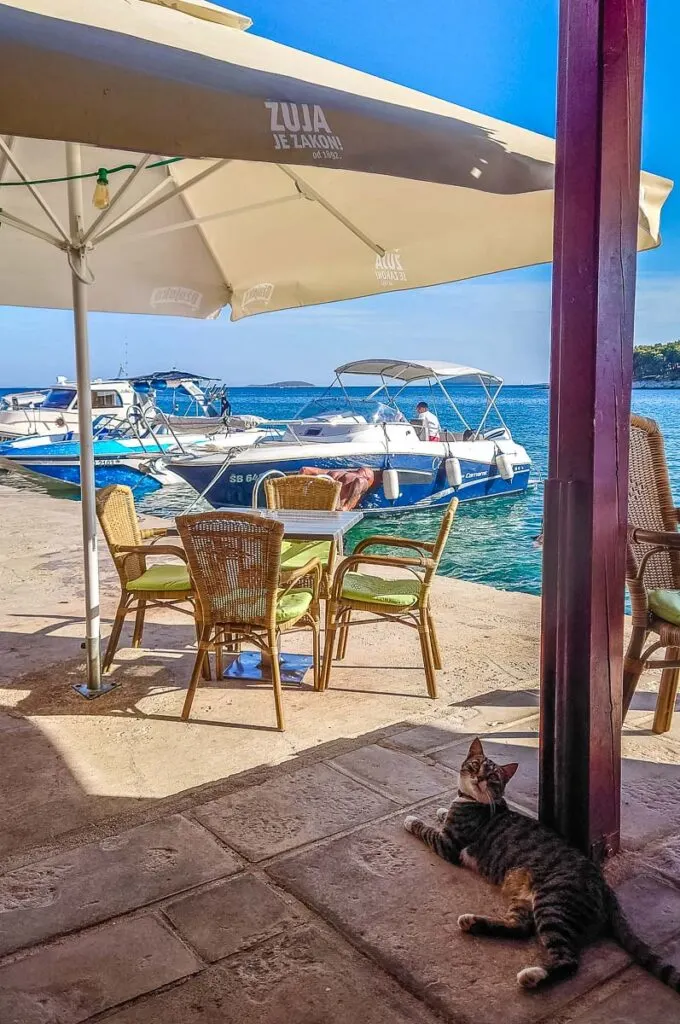
In the afternoon, we ferry-hopped to Prvić – the nearest to Zlarin inhabited island of the Šibenik Archipelago. Here, we had a delicious lunch at Gostionica Mareta. It was the first place on the seafront we saw as we got off the ferry. So, it was a bit of a gamble but it paid off. We had:
- octopus stew – my daughter;
- pašticada – my husband; and
- seafood risotto – myself.
We finished with rožata and ice cream. Sitting right by the water and enjoying the beautiful views across the Šibenik Archipelago and the Adriatic Sea made the food taste even more so delicious.
Boats would arrive and moor further down the quay. People would jump in the water for a refreshing swim, then open a towel directly on the cement quay, and sunbathe under the afternoon sun rays. Two cats came and stood between the tables to see who would share a morsel of their lunch with them. It was a peaceful, happy moment and stress, anger, and constant strive to be on top were words that didn’t exist on this small, blessed island.
After lunch, we headed to the adjacent Memorial Centre to learn a bit more about Prvić’s most notable person – the Renaissance polymath Faust Vrančić. A full-size installation represented his most intriguing and famous project – the Homo Volans – a parachuting man.
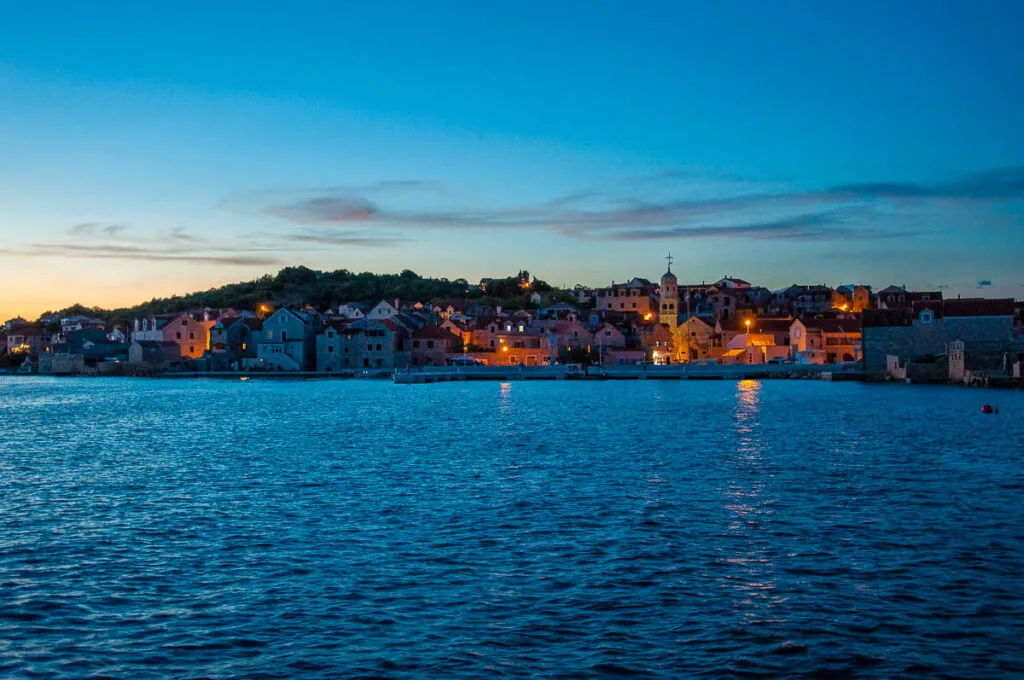
Then we followed the path from Prvić Luka to the other small village on the island – Šepurine. The walk took us through vineyards, past stone houses and the local cemetery. It ended at a small cove where we had one last dip in the water for the day. The sun started setting and it was time to head to the ferry port to get the last ferry for the day going back to Šibenik.
The day after – Sunday – we took a Uber to the village of Brodarica. Once there, we piled in a small boat – a private water taxi – with half a dozen other locals and visitors to the island of Krapanj. Only 300 m away from the mainland, we reached the island in less than five minutes to the joy of the baby who was travelling with his mummy and his buggy positioned on the boat’s bow.
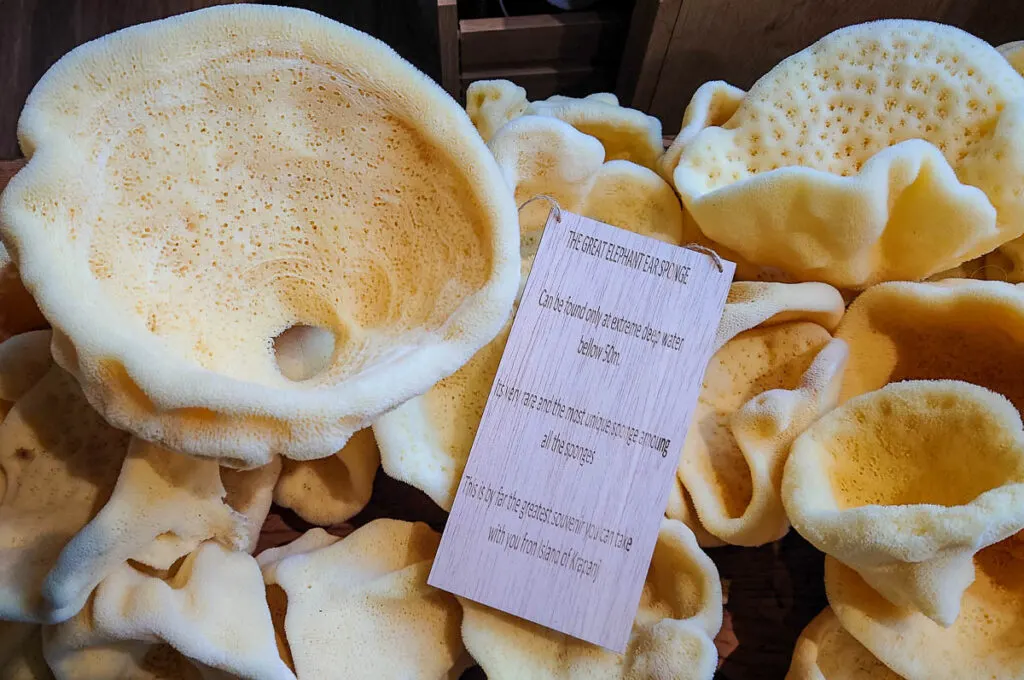
Krapanj – famous as a historic sea sponge diving spot – was stretching out under the hot Sunday sun. We popped into the small Diving Museum run by one of the diving families on the island.
Then, we followed the promenade to the only hotel here – Spongiola. We had a drink at the seafront bar and waited to see if an umbrella and sunloungers would become available on its small, well-appointed beach. We were not lucky. So, we continued walking. A pebbly beach was waiting for us right around the corner.
To our delight, the water here was very shallow, allowing us to walk far into the sea before we were submerged to our shoulders. It was a great place to snorkel. Krapanj’s centuries-old pine forest extended beyond the beach and framed the view of the island of Zlarin on the horizon. It was beautiful! The stuff that summer holidays are made of.
In Conclusion
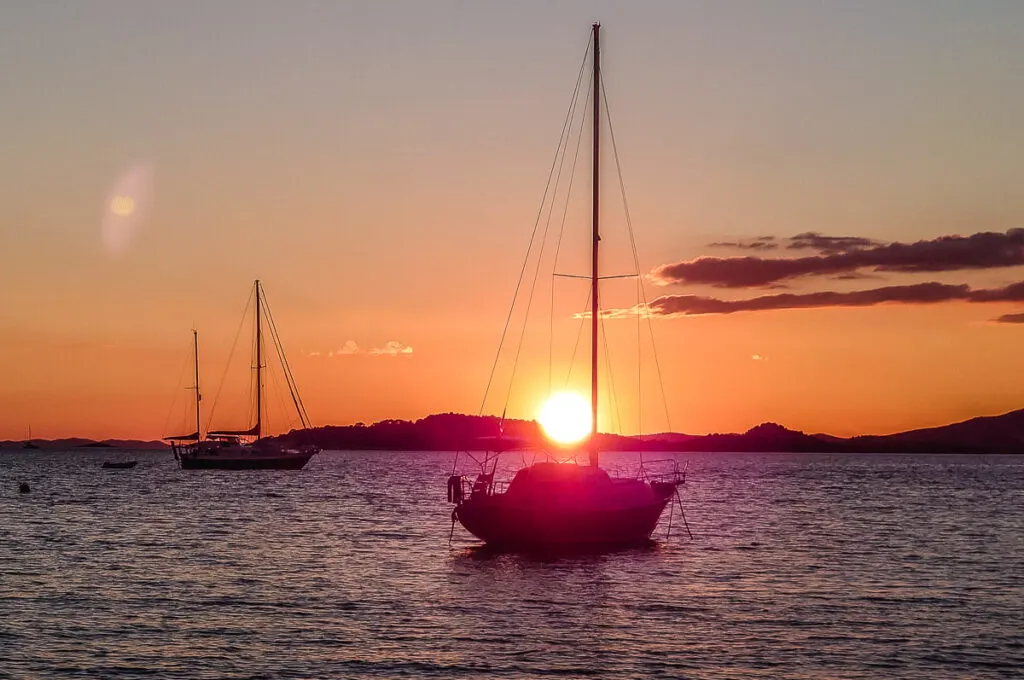
The Šibenik Archipelago is a cluster of 249 islands, islets, and rocks in the Adriatic Sea of Croatia. Just off the Dalmatian coast and a short ferry ride away from the third-largest Dalmatian city – Šibenik – the archipelago remains a hidden gem in Europe.
With only six of its islands permanently inhabited, this is a place where you can find peace, solitude, and direct contact with pristine nature. Not to mention the delicious Dalmatian cuisine, the numerous beaches, and the rich palette of local traditions and experiences.
In this blog post today, I shared with you detailed information on how to visit and explore the Šibenik Archipelago in Croatia. From how to get there by plane, ferry, bus, and organised tour to the best things to do and what each inhabited island stands out with, everything is covered.
I hope that you will find all of this of use when you are planning your adventures in Southeastern Europe.
Have a wonderful time exploring the little-known Šibenik Archipelago.
Enjoy the beauty of the Adriatic Sea and Croatia!
More Helpful Travel Info for You
Best of Croatia: Trogir, Baredine Cave
Best of Italy: Venice, Lake Garda, Veneto, Lombardy, Emilia-Romagna, Marche, Friuli Venezia Giulia, Trentino, Italy with Kids, Italy for Foodies, Day Trips in Italy, Hiking in Italy, Christmas in Italy
Best of Portugal: One Day in Aveiro, Photos of Aveiro, One Day in Porto, Photos of Porto, One Day in Guimarães, Photos of Guimarães, Photos of Braga, Sanctuary of Bom Jesus do Monte, The Best Portuguese Desserts and Pastries
Best of England: London, Kent, Dorset, East Sussex, Days Out in England
Travel: Travel Resources, The Joy of Travel, Safety Tips
Thank you for reading! Please, leave me a comment, pin the images or use the buttons right at the top and at the end of this blog post to share it on social media.
For more useful information like this, please, like my blog’s page on Facebook and subscribe to my strictly no-spam newsletter.
Pin This Blog Post!
